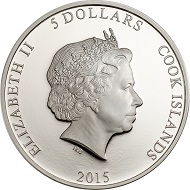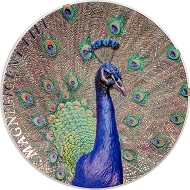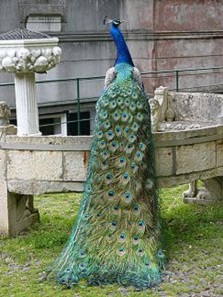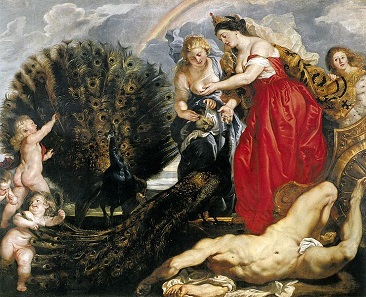January 21, 2015 – The amazing Indian peafowl graces the silver commemorative coin “Magnificent Life 2015 Peacock” which Coin Invest Trust has created by order of the Cook Islands.
Cook Islands / 5 Dollars / Silver .999 / 1 oz / 38.61 mm / Mintage: 999.
The obverse displays the Ian Rank-Broadley portrait of Queen Elizabeth II, alongside her name, the title of the issuing nation, and the nominal value. The concave reverse shows a colorful peacock fanning his tail. The animal’s upper body and head are set in high-relief. On the left, the inscription MAGNIFICENT LIFE.
Indian Peafowl. Photograph: Amanda Grobe und Nyla1 / https://creativecommons.org/licenses/by-sa/2.5/deed.en
Magnificent, majestic, iridescent – this is how the peacock presents itself when it performs courtship displays in order to impress the females. While its upper body and head glow in a luminous dark blue, the peacock’s tail covert feathers are its most impressive body part. Fanning the tail, the peacock renders visible its many “eyes”. Though initially meant to irritate predators, this optical effect also holds a deep fascination for the human observer.
The peacock’s tail feathers, usually dragged along in a 1.5 meter long train, are understandably one of the most coveted finds for zoo visitors. They were a source of inspiration even for evolutionary biologist Charles Darwin. At first he believed that the long train must surely impede the animal’s ability to fly or escape and thus be a disadvantage in the process of natural selection. But, in fact, quite the contrary is true: Only individuals that are especially strong and healthy, like a stag with its large antlers, can afford such cumbersome ornaments.
Juno and Argus, painting by Peter Paul Rubens, ca. 1611. Wallraff-Richartz-Museum Cologne
The blue-colored Indian Peafowl (Pavo cristatus) already occupied a special place in Greek mythology: So Zeus’s wife Hera adorned the peacock’s feathery coat with the many eyes of the giant Argus Panoptes, literally the “all-seeing”, to watch over Io until it was killed by Hermes. The early Christians understood the peacock as a symbol of resurrection and the animal is worshipped as a national bird in modern-day India. 13th-century Islamic poet Saadi even believed that the only thing pure enough to serve as a bookmark for the Koran was the feather of a peacock.
By order of the Cook Islands, Coin Invest Trust dedicates a commemorative coin to this divine bird. The extravagant high-relief mintage of the concave reverse presents a peacock fanning its tail. The brilliant colors and the concave design of the reverse capture the full beauty and magnificence of the displaying peacock. The intricate detail in the replication of the peacock feathers is made possible only thanks to state-of-the-art minting technology.
The coin is minted by B. H. Mayer’s Kunstprägeanstalt GmbH. Collectors can purchase the issue through specialty dealers.
More information on this and other CIT releases is available here.
For reading an interesting article on how the peacock got its tail, please click here.
And here you watch an Indian Peafowl fanning its tail.








